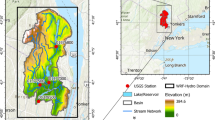Abstract
A methodology for evaluating real-time optimal reservoir releases under flooding conditions that minimizes flood damages for a river-reservoir system is described in this paper. The problem is formulated as a discrete-time optimal control problem in which reservoir releases are the control variables, and water surface elevations and discharges are the state variables. Constraints imposed on the reservoir’s water surface elevations and reservoir releases to the downstream reaches are incorporated into an objective function using a penalty function method. The optimal control model consists of the two primary interfaced components: (1) the U.S. Geological Survey Full EQuation routing model to simulate the unsteady flow dynamics of the river-reservoir system and (2) an optimization technique, simulated annealing that optimizes reservoir releases (flood control gate operations) subject to system constraints. The model solves an augmented control problem. The model was applied to the river-reservoir system of Lake Travis on the Lower Colorado River in Texas. The model application to Lake Travis revealed the usefulness of the model in improving a given operation policy, regardless of the type objective function (linear or nonlinear). The methodology and the operation model developed here are unique since they can be applied to any river-reservoir system, do not require simplification of nonlinearities, and guarantee the determination of an optimal or near-global optima.









Similar content being viewed by others
References
Ahmed E-SMS (2006) Real-time optimal operation of reservoir-river systems under flooding conditions. PhD dissertation, Arizona State University, Tempe, AZ
Danish Hydraulics Institute (DHI) (2005) MIKE 11—A modeling system for rivers and channels. DHI Water and Environment, Denmark
Franz DD, Melching CS (1997a) Full equations (FEQ) model for the solution of the full, dynamic equations of motion for one-dimensional unsteady flow in open channels and through control structures. US Geological Survey Water-Resources Investigations Report 96-4240
Franz DD, Melching CS (1997b) Full equations utilities (FEQUTL) model for the approximation of hydraulic characteristics of open channels and control structures during unsteady flow. US Geological Survey Water-Resources Investigations Report 97-4037, 205 p
Fread DL (1978) NWS operational dynamic wave model. Verification of mathematical and physical models in hydraulic engineering. Proceedings, 26th annual hydraulics division specialty conference, College Park, MD, pp 455–464
Fread DL (1998) NWS FLDWAV model: theoretical description, office of hydrology. US National Weather Service (NWS), NOAA, Washington, DC
Kirkpatrick S, Gelatt CD Jr, Vecchi MP (1983) Optimization simulated annealing. Science 220(4598):671–680
Lasdon LS, Warren AD (1978) Generalized reduced gradient software for linearly and nonlinearly constrained problems. In: Greenberg HJ (ed) Design and implementation of optimization software. Sijthoff and Noordhoff, The Netherlands, pp 363–397
Lasdon LS, Warren AD, Jain A, Ratner M (1978) Design and testing of a generalized reduced gradient code for nonlinear programming. ACM Trans Math Softw 4:34–50
Madsen H, Skotner C (2005) Adaptive state uploading in real-time river flow forecasting—a combined filtering and error forecasting procedure. J Hydrol 308(1–4):302–312
Mays LW (1990) Flood simulation for a large reservoir system in the Lower Colorado river Basin, Texas. National Water Summary 1988-89-Floods and Droughts, Institutional and Management Aspects, U.S. Geological Survey Water-Supply Paper 2375
Mays LW (1997) Optimal control of hydrosystems. Marcel Dekker, New York
Mays LW, Unver OI, Lansey KE (1987) Real time flood management model for Highland Lake System. J Water Resour Plan Manag 113(5):620–638
Unver OL, Mays LW (1990) Model for real-time optimal flood control operation of a reservoir system. Water resources management, vol 4, pp 21–46. Kluwer, Dordrecht, The Netherlands
U.S. Army Corps of Engineers (USACE) (2010a) Hydrologic engineering center, HEC-RAS: river analysis system, hydraulic reference manual, Version 4.1, Davis, CA
U.S. Army Corps of Engineers (USACE) (2010b) Hydrologic engineering center, hydrologic modeling system HEC-HMS: User’s Manual, Version 3.5, Davis, CA
Author information
Authors and Affiliations
Corresponding author
Rights and permissions
About this article
Cite this article
Ahmed, ES.M.S., Mays, L.W. Model for determining real-time optimal dam releases during flooding conditions. Nat Hazards 65, 1849–1861 (2013). https://doi.org/10.1007/s11069-012-0444-6
Received:
Accepted:
Published:
Issue Date:
DOI: https://doi.org/10.1007/s11069-012-0444-6




